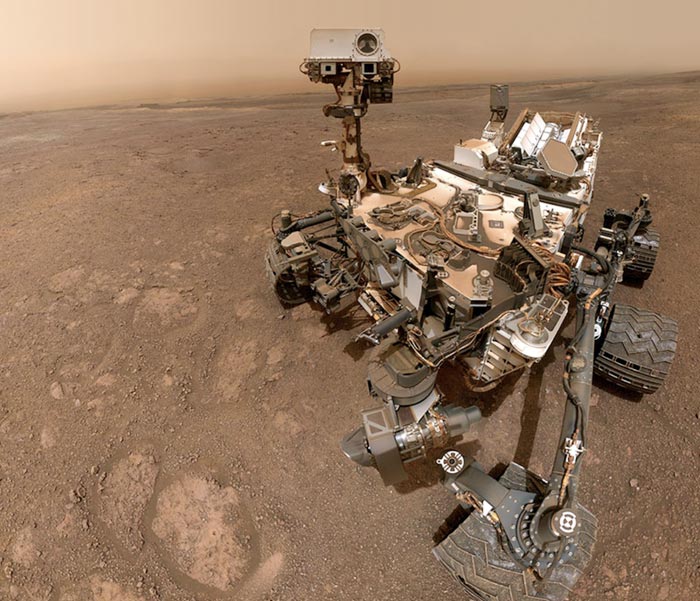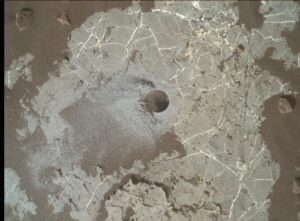Newly discovered carbon may yield clues to ancient Mars

A selfie taken by NASA's Curiosity Mars rover on Sol 2291 at the "Rock Hall" drill site, located on Vera Rubin Ridge. Reduced carbon released from powder from this drill hole was strongly depleted in carbon 13, the surprising carbon isotopic signature reported by the team. The selfie is composed of 57 individual images taken by the rover's Mars Hand Lens Imager (MAHLI), a camera on the end of the rover's robotic arm.
Credit: NASA/Caltech-JPL/MSSS
NASA’s Curiosity rover landed on Mars on Aug. 6, 2012, and since then has roamed Gale Crater taking samples and sending the results back home for researchers to interpret. Analysis of carbon isotopes in sediment samples taken from half a dozen exposed locations, including an exposed cliff, leave researchers with three plausible explanations for the carbon’s origin — cosmic dust, ultraviolet degradation of carbon dioxide, or ultraviolet degradation of biologically produced methane.
The researchers note today (Jan.17) in Proceedings of the National Academy of Sciences that “All three of these scenarios are unconventional, unlike processes common on Earth.”
Carbon has two stable isotopes, 12 and 13. By looking at the amounts of each in a substance, researchers can determine specifics about the carbon cycle that occurred, even if it happened a very long time ago.
“The amounts of carbon 12 and carbon 13 in our solar system are the amounts that existed at the formation of the solar system,” said Christopher H. House, professor of geosciences, Penn State. “Both exist in everything, but because carbon 12 reacts more quickly than carbon 13, looking at the relative amounts of each in samples can reveal the carbon cycle.”

Credit: NASA/Caltech-JPL/MSSS
Curiosity, which is led by NASA’s Jet Propulsion Laboratory in Southern California, has spent the last nine years exploring an area of Gale Crater that has exposed layers of ancient rock. The rover drilled into the surface of these layers and recovered samples from buried sedimentary layers. Curiosity heated the samples in the absence of oxygen to separate any chemicals. Spectrographic analysis of a portion of the reduced carbon produced by this pyrolysis showed a wide range of carbon 12 and carbon 13 amounts depending on where or when the original sample formed. Some carbon was exceptionally depleted in carbon 13 while other carbon samples where enriched.
“The samples extremely depleted in carbon 13 are a little like samples from Australia taken from sediment that was 2.7 billion years old,” said House. “Those samples were caused by biological activity when methane was consumed by ancient microbial mats, but we can’t necessarily say that on Mars because it’s a planet that may have formed out of different materials and processes than Earth.”
To explain the exceptionally depleted samples, the researchers suggest three possibilities — a cosmic dust cloud, ultraviolet radiation breaking down carbon dioxide, or ultraviolet degradation of biologically created methane.
According to House, every couple of hundred million years the solar system passes through a galactic molecular cloud.
“It doesn’t deposit a lot of dust,” said House. “It is hard to see any of these deposition events in the Earth record.”
To create a layer that Curiosity could sample, the galactic dust cloud would have first lowered the temperature on a Mars that still contained water and created glaciers. The dust would have deposited on top of the ice and would then need to remain in place once the glacier melted, leaving behind a layer of dirt that included the carbon.
So far, there is limited evidence of past glaciers at Gale Crater on Mars. According to the researchers, “this explanation is plausible, but it requires additional research.”
A second possible explanation for lower amounts of carbon 13 is the ultraviolet conversion of carbon dioxide to organic compounds like formaldehyde.
“There are papers that predict that UV could cause this type of fractionation,” said House. “However, we need more experimental results showing this size fractionation so we can rule in or rule out this explanation.”
The third possible method of producing carbon 13 depleted samples has a biological basis.
On Earth, a strongly carbon 13 depleted signature from a paleosurface would indicate past microbes consumed microbially produced methane. Ancient Mars may have had large plumes of methane being released from the subsurface where methane production would have been energetically favorable. Then, the released methane would either be consumed by surface microbes or react with ultraviolet light and be deposited directly on the surface.
However, according to the researchers, there is currently no sedimentary evidence of surface microbes on the past Mars landscape, and so the biological explanation highlighted in the paper relies on ultraviolet light to place the carbon 13 signal onto the ground.
“All three possibilities point to an unusual carbon cycle unlike anything on Earth today,” said House. “But we need more data to figure out which of these is the correct explanation. It would be nice if the rover would detect a large methane plume and measure the carbon isotopes from that, but while there are methane plumes, most are small, and no rover has sampled one large enough for the isotopes to be measured.”
House also notes that finding the remains of microbial mats or evidence of glacial deposits could also clear things up, a bit.
“We are being cautious with our interpretation, which is the best course when studying another world,” said House.
Curiosity is still collecting and analyzing samples and will be returning to the pediment where it found some of the samples in this study in about a month.
“This research accomplished a long-standing goal for Mars exploration,” said House. “To measure different carbon isotopes — one of the most important geology tools — from sediment on another habitable world, and it does so by looking at 9 years of exploration.”
Also working on the project from Penn State was Gregory M. Wong, recent doctoral recipient in geosciences.
Other participants in the research were, at NASA Jet Propulsion Laboratory: Christopher R. Webster, fellow and senior research scientist; Gregory J. Flesch, scientific applications software engineer; and Amy E. Hofmann, research scientist; at Solar System Exploration Division, NASA Goddard Space Flight Center: Heather B. Franz, research scientist; Jennifer C. Stern, research assistant; Alex Pavlov, space scientist; Jennifer L. Eigenbrode, research assistant; Daniel P. Glavin, associate director for strategic science; Charles A. Malespin, chief, Planetary Environments Laboratory; and Paul R. Mahaffy, Retired Solar System Exploration Division Director; at University of Michigan: Sushil K. Atreya, professor of climate and space sciences and engineering and director of the Planetary Science Laboratory; at Carnegie Institution for Science: Andrew Steele, scientist; and at Georgetown University and NASA Goddard Space Flight Center: Maëva Milan, postdoctoral fellow.
NASA supported this project.
Journal: Proceedings of the National Academy of Sciences
Article Title: Depleted carbon isotope compositions observed at Gale crater, Mars
Article Publication Date: 17-Jan-2022
Media Contact
A’ndrea Messer
Penn State
aem1@psu.edu
Office: 814-865-9481
All latest news from the category: Physics and Astronomy
This area deals with the fundamental laws and building blocks of nature and how they interact, the properties and the behavior of matter, and research into space and time and their structures.
innovations-report provides in-depth reports and articles on subjects such as astrophysics, laser technologies, nuclear, quantum, particle and solid-state physics, nanotechnologies, planetary research and findings (Mars, Venus) and developments related to the Hubble Telescope.
Newest articles

Innovative 3D printed scaffolds offer new hope for bone healing
Researchers at the Institute for Bioengineering of Catalonia have developed novel 3D printed PLA-CaP scaffolds that promote blood vessel formation, ensuring better healing and regeneration of bone tissue. Bone is…

The surprising role of gut infection in Alzheimer’s disease
ASU- and Banner Alzheimer’s Institute-led study implicates link between a common virus and the disease, which travels from the gut to the brain and may be a target for antiviral…

Molecular gardening: New enzymes discovered for protein modification pruning
How deubiquitinases USP53 and USP54 cleave long polyubiquitin chains and how the former is linked to liver disease in children. Deubiquitinases (DUBs) are enzymes used by cells to trim protein…


